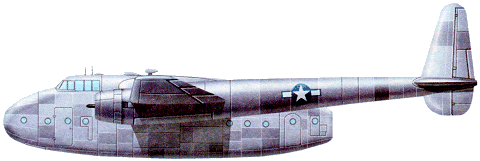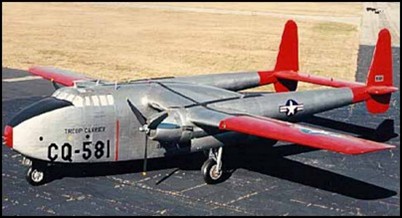|
| To meet a US Army requirement of 1941 for a specialised military freighter, Fairchild began work on the design of its Fairchiid F-78. Following approval of the design and a mock-up in 1942, a contract for a single prototype was awarded and the designation XC-82 allocated. First flown on 10 September 1944, the XC-82 was a cantilever high-wing monoplane of all-metal construction, the roomy fuselage incorporating a flight deck for a crew of five and a large-capacity cabin/cargo hold with clamshell doors at the rear to provide easy access for wheeled ortracked vehicles. The rear doors could be removed completely for the deployment of heavy loads by parachute-extraction techniques, and could accommodate 78 persons for emergency evacuation, 42 fully-equipped paratroopers or 34 stretches. The fuselage was supported on the ground by robust retractable tricycle landing gear and power provided by two 1566kW Pratt & Whitney R-2800-34 Double Wasp 18-cylinder radial engines in wing-mounted nacelles. Extending aft from these nacelles were tail-booms carrying twin fins and rudders and united at the rear by the tailplane mounting a single elevator.

The US Army Air Force placed an initial contract for 100 C-82A aircraft, these being named Packet. The first were delivered for evaluation in 1945 and a contract for 100 more followed. Because of wartime demands a second production line was laid down by North American Aviation at Dallas, Texas, but from a contract for 792 C-82N only three were completed before the general rash of contract cancellations that followed VJ Day. Fairchiid eventually built a total of 220 with deliveries ending in 1948. Although too late to operate during World War II, the Packet provided valuable service to the USAF's Tactical Air Command and Military Air Transport Service before it was retired in 1954.
 | A three-view drawing (800 x 533) |
| MODEL | C-82A |
| CREW | 5 |
| PASSENGERS | 42-78 |
| ENGINE | 2 x Pratt & Whitney R-2800 Double Wasp, 1566kW |
| WEIGHTS |
| Loaded weight | 24300 kg | 53573 lb |
| Payload | 78 passangers or 42 paratroopers | 172 lb |
| DIMENSIONS |
| Wingspan | 32.46 m | 107 ft 6 in |
| Length | 23.5 m | 77 ft 1 in |
| Height | 8.03 m | 26 ft 4 in |
| PERFORMANCE |
| Max. speed | 400 km/h | 249 mph |
| Cruise speed | 260 km/h | 162 mph |
| Ceiling | 8000 m | 26250 ft |
| Range w/max.fuel | 3400 km | 2113 miles |
| Patrick Romero, e-mail, 24.01.2010 21:45 The 3-view schematics on this page are of the C-119, which is in essence a redesigned C-82 Packet. There are a few websites that have the schematics of the original C-82 Packet. Incidentally, the escape plane in The Flight of the Phoenix was made out of different materials: the back half of the fuselage was made out of metal tubing covered in wood, as were the tail fin and the stabilizer, but the front fuselage was made of metal, and the wings, which came off of a Beech C-45, according to www.aerovintage.com /phoenix.htm, were also made of metal. Even though the skids were made of fiberglass for the filming, this mixed material use would have made the plane nose heavy. Besides, the wings were really not the correct size in accordance to the plans: they were nearly the correct shape, but were scaled down. also, the fuselage behind the wings was too short to truly match the tail booms of the C-82 Packet. I made a model of the escape plane for a simulator, and when I tried to fly it, it proved to be tail-heavy, or perhaps there was too much lift, but when I added the windscreens, some of the excess lift was eliminated. I was careful on the all of the details to make it perfectly match the exact shape of the escape plane construction prop, which was used for the engine start-up scene.The C-82 Packet was an okay design, it just needed more power. reply | | Charles Evans, 27.10.2009 19:14 Star of the Flight of the Phoenix movie in which the damaged C-82 was cannibalised to create a conventional high wing escape plane using a nacelle and tail boom. It flew in reality but badly and crashed killing its pilot. Thereafter a stunt double was used. reply | | Al Hodges, e-mail, 29.07.2009 09:52 In March 1947, our class was the first to make all five jumps in Ft. Benning from the C-82. While stationed at Ft. Bragg with the 82nd Airborne Division, a C-82 lost an engine shortly after take-off. The underpowered C-82 with 42 paratroopers could not maintain altitude with only one engine. The jumpmaster managed to get the men hooked up, cleared the plane and only the Air Force crew was killed. The jumpmaster was too late for his parachute to fully open, but fortunately he was over pine trees and a tree caught his partially open chute and he lived. reply |
|
Do you have any comments?
|
| 
COMPANY
PROFILE
All the World's Rotorcraft
|









